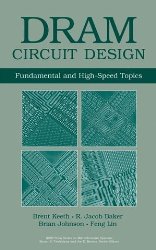Engineering Bookshelf
- Aerospace
- Biological
- Civil
- Chemical
- Environmental
- Electrical
- Materials
- Mechanical
- Petroleum
- Geoengineering
- Software

DRAM Circuit Design: Fundamental and High-Speed Topics
by Brent Keeth, R. Jacob Baker, Brian Johnson, Feng LinPublisher: Wiley-IEEE Press
ISBN: 0470184752
Check price @ amazon.com , amazon.ca , amazon.co.uk
Book Description
Dynamic Random Access Memory (DRAM) technology has been one of the greatestdriving forces in the advancement of solid-state technology. With its ability to produce high product volumes and low pricing, it forces solid-state memory manufacturers to work aggressively to cut costs while maintaining, if not increasing, their market share. As a result, the state of the art continues to advance owing to the tremendous pressure to get more memory chips from each silicon wafer, primarily through process scaling and clever design.
From a team of engineers working in memory circuit design, DRAM Circuit Design gives students and practicing chip designers an easy-to-follow, yet thorough, introductory treatment of the subject. Focusing on the chip designer rather than the end user, this volume offers expanded, up-to-date coverage of DRAM circuit design by presenting both standard and high-speed implementations. Additionally, it explores a range of topics: the DRAM array, peripheral circuitry, global circuitry and considerations, voltage converters, synchronization in DRAMs, data path design, and power delivery. Additionally, this up-to-date and comprehensive book features topics in high-speed design and architecture and the ever-increasing speed requirements of memory circuits.
A modern, comprehensive introduction to DRAM for students and practicing chip designers
The only book that covers the breadth and scope of the subject under one cover, DRAM Circuit Design is an invaluable introduction for students in courses on memory circuit design or advanced digital courses in VLSI or CMOS circuit design. It also serves as an essential, one-stop resource for academics, researchers, and practicing engineers.
About the Author
Brent Keeth is a Fellow in DRAM Design R&D at Micron Technology, Inc. His twenty-five years of industry experience spans radar systems, avionics components, communicationsystems, professional production and post-production equipment for the broadcast television industry, and solid-state memory. He holds over 400 U.S. and foreign granted or pending patents.
R. Jacob Baker, PhD, is an engineer, educator, and inventor. He has more than twenty years of engineering experience and holds over 200 granted or pending patents in integrated circuit design. Dr. Baker is the author of several circuit design books. For a detailed biography, see http://cmosedu.com/jbaker/jbaker.htm.
Brian Johnson is a Senior Design Engineer in DRAM Design R&D at Micron Technology, Inc. His research interests include asynchronous sequential circuits, clock synchronization circuits, and high-speed logic design. He holds over 60 granted or pending patents related to DRAM design and integrated circuit design.
Feng Lin, PhD, is a Senior Design Engineer in DRAM Design R&D at Micron Technology, Inc. His research interests include high-speed I/O circuits, PLL/DLL, and mixed-signal circuit design. Dr. Lin holds over 50 granted or pending patents related to DRAM and integrated circuit design.
Customer Reviews
By Nhon Quach
I had spent a lot of time looking for a good DRAM book on the web as well as the IEEE library since my understanding on the topic was very fragmented until I found this book. Quite frankly, this is probably the only book you will ever need for understanding the internals of the DRAM device (besides reading the relevant JEDEC specs of course). The book covered a lot of topics (layout issues, PLLs, sense amp, synchronization, etc.) with a lot of details, allowing me to finally get a global view of how DRAMs are designed and work.
I don't have time for a detailed recommendation now, but I strongly recommend this book and promise I will come back and write a more detailed review for this book. I feel like I owe the author this much.
By David T. Wang
I'm one of the Co-authors of the book "Memory Systems:Cache, DRAM, Disk". I wrote the section on DRAM memory systems. So my understanding of DRAM devices is from the systems perspective - i.e. as a user of DRAM devices.
When I was searching for literature to aid in my understanding of DRAM devices, and writing the aforementioned text, I relied on Keeth and Baker's previous effort, the book titled "DRAM Circuit Design: A Tutorial". That book was enormously helpful in providing the basis reference for my understanding of basic DRAM circuits and microarchitecture. With that understanding in place, I was then able to absorb the significance of current academic papers being presented at technical conferences. In that sense, the book "DRAM Circuit Design: A Tutorial" literally functioned as a Rosetta Stone for me.
This current book, "DRAM Circuit Design: Fundamental and High-Speed Topics" has not only carried on that tradition of being the relevant, current and definitive reference, but it extends the scope of coverage to lower latency devices such as RLDRAM, and higher bandwidth devices such as GDDR3.
It is therefore my opinion that this is one of the best book purchases that I have made in my professional career, and I highly recommend to anyone interested in the understanding of DRAM device operations to purchase this book.